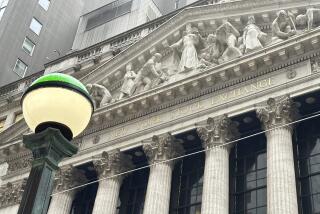In Bond Funds, Risk Takers Are Rewarded
With Treasury bond yields sinking to generational lows in 2003, investors who were willing to shoulder more risk in their quest for income hit pay dirt.
U.S. government bond mutual funds -- the bedrock of many a conservative portfolio -- posted an average total return of 1.9% last year, meaning interest earnings plus or minus the net change in principal value, according to data tracker Morningstar Inc.
By contrast, junk bond funds, which buy the debt of troubled companies and were battered in the economic downturn earlier in the decade, rebounded sharply with a total return of 24.1% for the year, including 5.6% in the fouth quarter.
Funds that invest in bonds issued by the governments of so-called emerging markets -- nations with fast-growing but often volatile economies -- soared an average of 30.1% in 2003.
“It was the search for yield,” said Andrew Clark, senior research analyst at fund tracker Lipper Inc. in Denver. “Investors were more than willing to take on additional risk to get that extra yield. They worked wonders in emerging market and high-yield debt funds.”
A year ago, investors were girding for an avalanche of blockbuster corporate bankruptcies in the wake of the debacles at Enron and WorldCom, said portfolio manager Stephen Kane of the Metropolitan West Total Return Bond fund in Los Angeles, which returned 13.9% in 2003 (versus 4.9% for the intermediate-term investment-grade category).
Early on, “it was an environment of almost unprecedented risk aversion,” Kane recalled. “The market was solely interested in the safest of assets: Treasuries and mortgage securities. They were pricing in Armageddon.”
Junk bond yields were about 9 percentage points above those for Treasury securities of comparable maturity -- a huge risk premium by historical standards.
But as 2003 progressed, Kane said, “investors began to learn that risk was not a four-letter word.”
The gap between Treasury and junk bond yields has slimmed significantly, to about 4 percentage points, meaning there is less “risk premium” available. Junk debt, so-called because it is rated below investment grade by services such as Moody’s and Standard & Poor’s, carries much greater default risk than higher-quality bonds.
Veteran manager Robert Rodriguez of the FPA New Income fund in Los Angeles steered his portfolio to a return of 8.3% in 2003 despite his aversion to risk. Since Rodriguez took over in 1983, the intermediate investment-grade fund has not had a down year.
In 2003, exposure to the high-yield sector helped juice his returns. Rodriguez had about 25% of the portfolio in junk bonds at the start of last year -- about as high an allocation as he has ever allowed.
The fund also got a boost from the euro’s big surge versus the dollar, as FPA New Income had invested in inflation-indexed bonds denominated in the European currency.
Strong junk bond specialty funds in 2003 included Loomis Sayles Institutional High Income, up 48%, and Fidelity Advisor High Income Advantage, up 43.6%.
In the emerging market debt category, winners included AllianceBernstein Emerging Markets Debt, up 38.4%, and Pimco Emerging Markets Bond, up 32.6%.
Among government debt funds, relatively strong performers included Pimco Real Return, which focuses on inflation-adjusted securities, up 8.5%; Dreyfus U.S. Treasury Long Term, up 4.5%; and One Group Bond, up 3.8%.
Despite California’s deep fiscal crisis, investors seeking tax-free income saw total returns of 4.2%, on average, in the state’s long-term municipal bond funds and 3.3% in intermediate- and short-term muni funds.
This year, some analysts expect the trends of 2003 to continue. An improving economy and a moderate rise in interest rates -- a scenario many bullish economists are predicting -- would be beneficial for corporate bonds relative to Treasuries, said Lipper’s Clark.
Rising market interest rates cause older fixed-rate bonds to decline in value. The effect can be worst for lower-yielding bonds.
Clark said he would underweight Treasury and mortgage-backed securities, which tend to lag in such an environment, in favor of high-yield, investment-grade corporate and foreign debt.
Rodriguez said that although high-yield could have more upside, he is positioning his portfolio far differently from last year.
Junk is down to 16% of his portfolio, a weighting that could be cut to 10% by midyear, he said.
“The good news on high-yield is out,” Rodriguez said, noting that junk mutual funds have been flooded with cash inflows from performance-minded investors. “I never like to have a lot of company around me.”
Rodriguez has been restructuring his portfolio in anticipation of possible interest rate increases this year by the Federal Reserve. “Very few are as defensive as we are,” he said.
The Fed could raise its target short-term interest rate, now 1%, by as much as 1 percentage point during the next 12 to 15 months, Rodriguez said.
Nobody knows when -- or to what extent -- the Fed will act to stem inflation, although some economists anticipate the first move as early as this spring, even though it’s a presidential election year. “Even small increases in interest rates will have a dramatic impact on [bonds’] total return,” Rodriguez said.
The yield on the benchmark 10-year T-note, currently at 4.24%, could approach 6% late this year, he said.
Portfolio manager Kane said he and his co-managers also are acting in anticipation of rate increases.
When the Fed starts a rate-raising campaign, the bond market can react swiftly and even shorter-term Treasuries can get devalued, Kane said.
Kane said MetWest sees value in TIPS, or Treasury Inflation Protected Securities; corporate bonds in the auto, insurance and airline sectors; and highly rated asset-backed securities such as home equity and manufactured-housing instruments.
More to Read
Inside the business of entertainment
The Wide Shot brings you news, analysis and insights on everything from streaming wars to production — and what it all means for the future.
You may occasionally receive promotional content from the Los Angeles Times.










